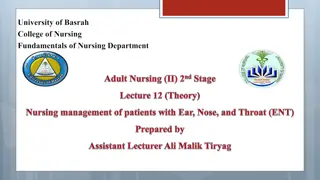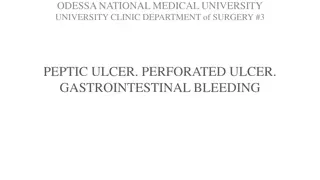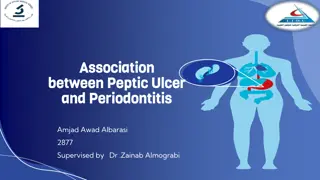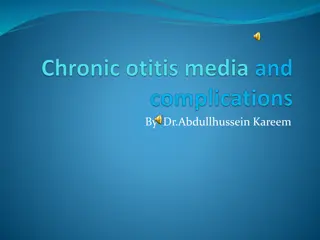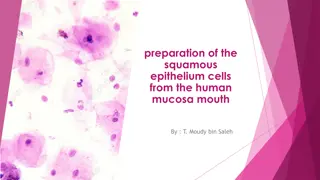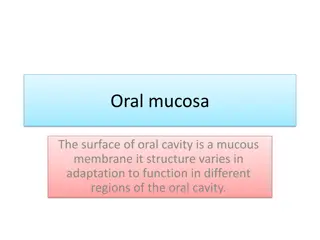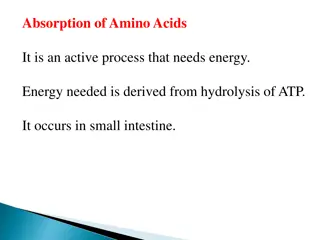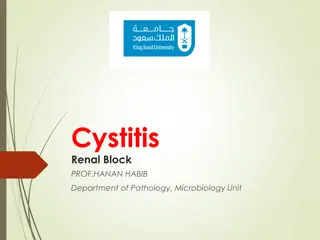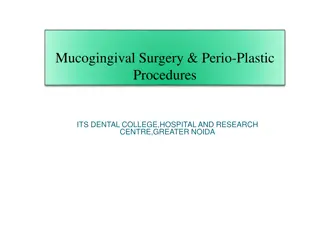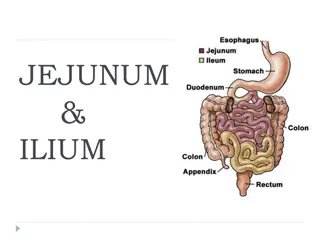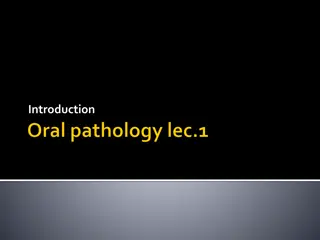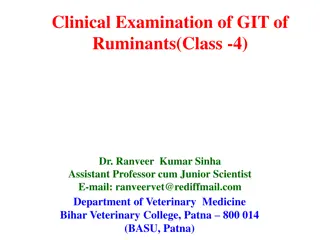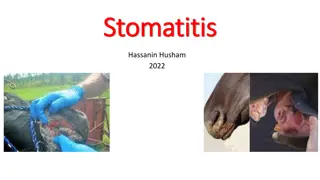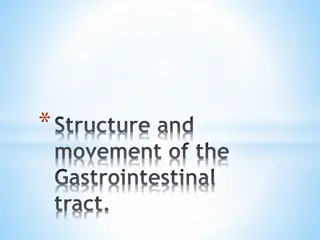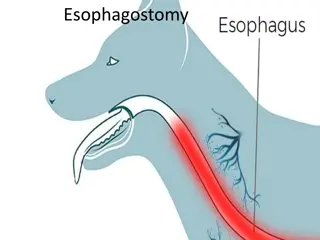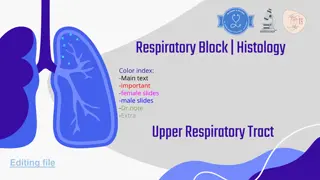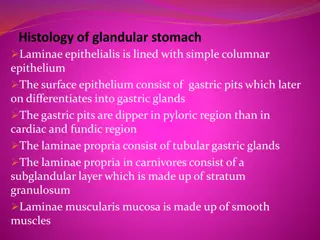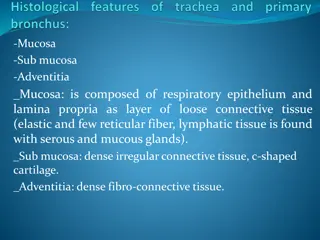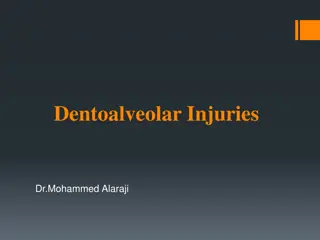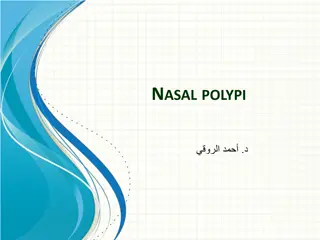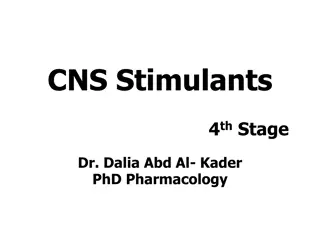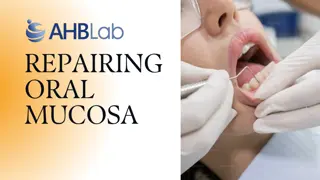Understanding Rhinosinusitis: Symptoms, Causes, and Classification
Rhinosinusitis, formerly known as sinusitis, is an inflammation affecting the paranasal sinuses, nasal mucosa, and nasal cavity. This condition is categorized based on the duration of symptoms as acute, subacute, or chronic. Various factors contribute to the development of rhinosinusitis, including
3 views • 46 slides
Understanding Peptic Ulcer Disease: Causes, Symptoms, and Treatment
Peptic ulcer disease (PUD) involves ulcerations in the duodenal or gastric mucosa caused by factors like Helicobacter pylori infection and NSAID use. Symptoms include abdominal pain and nausea, and treatment often involves H. pylori eradication and proton pump inhibitors to prevent complications lik
1 views • 77 slides
Anatomy of Intestine in Domestic Animals
The intestine in domestic animals plays a vital role in digestion and absorption. It consists of the small intestine for chemical digestion and absorption and the large intestine for water absorption and excretion. This article covers the gross anatomy, histology, and embryology of the intestine, de
2 views • 84 slides
Association Between Peptic Ulcer and Periodontitis: Insights and Connections
Previous studies have suggested a potential link between peptic ulcer disease (PUD) and periodontitis. PUD affects the gastrointestinal mucosa, with key risk factors being H. pylori infection and NSAID use, while periodontitis is an inflammatory disease affecting the tissues around teeth. Understand
0 views • 17 slides
Understanding Atrophic Rhinitis: Causes, Symptoms, and Diagnosis
Atrophic rhinitis is a progressive chronic condition characterized by the atrophy of nasal mucosa and turbinates. It predominantly affects young to middle-aged adults, with females being more prone. Commonly isolated bacteria include Klebsiella ozaenae and others. The pathophysiology involves metapl
0 views • 12 slides
Understanding Allergic Rhinitis: Causes, Symptoms, and Treatment
Allergic rhinitis is an atopic disease characterized by inflammation of the nasal mucosa due to hypersensitivity reactions. It commonly peaks in the second to fourth decades of life, with symptoms such as nasal irritation, sneezing, watery discharge, and more. Risk factors include family history, al
0 views • 10 slides
Insights into Tyzzer's Disease: An Overview of a Bacterial Infection in Laboratory Animals
Tyzzer's disease is an acute bacterial infection affecting rodents and rabbits, caused by Clostridium piliforme. Discovered in 1917 by Ernest Tyzzer, the disease is characterized by necrotic lesions in the caecal mucosa, liver, and heart. Initially known as Bacillus piliformis, it was later renamed
2 views • 21 slides
Chronic Otitis Media: Classification, Causes, and Management
Chronic otitis media is a persistent inflammation of the middle ear mucosa and mastoid process for more than 3 months. It can be classified as tubotympanic or attico-antral, with the new classification including inactive and active mucosal and squamous types. The condition is influenced by factors l
0 views • 36 slides
Preparation of Squamous Epithelium Cells from Human Mucosa Mouth
Squamous cells from the mucosa of the human mouth play vital roles in protecting and maintaining oral health. This guide outlines the steps to prepare slides of these cells for microscopic examination using simple materials and methods. Caution is advised when handling methylene blue due to its toxi
0 views • 7 slides
Understanding Oral Mucosa: Structure and Classification
The oral mucosa is a mucous membrane that adapts to different functions in various regions of the mouth. It is classified into masticatory, lining, and specialized mucosa, each with distinct characteristics. The structure of oral mucosa resembles skin and consists of epithelium and connective tissue
3 views • 31 slides
Understanding Peptic Ulcer Disease and Dyspepsia: Causes and Pathogenesis
Peptic ulcer disease and dyspepsia are common gastrointestinal conditions. Dyspepsia presents with upper abdominal pain and may or may not be associated with peptic ulcers. The most prevalent causes of dyspepsia include non-ulcer dyspepsia, GERD, and peptic ulcers. Peptic ulcers account for a signif
0 views • 24 slides
Amino Acid Absorption Mechanisms in Small Intestine
Amino acid absorption in the small intestine is an active process requiring energy derived from ATP hydrolysis. It involves two main mechanisms: carrier proteins transport system and glutathione transport system. The carrier proteins transport system uses ATP energy for absorption, while glutathione
0 views • 18 slides
Restore and Repair Oral Mucosa with Advanced Dental Care Peptide
Discover top-quality dental care peptides designed to repair and restore oral mucosa. As a leading supplier in Europe, we offer advanced peptide solutions that enhance oral health, promoting faster healing and improved resilience of the mucosal tissu
1 views • 8 slides
Understanding Cystitis: Causes, Symptoms, and Management
Cystitis is a common urinary tract infection affecting both men and women, characterized by inflammation of the bladder mucosa. This article covers the definition, pathogenesis, risk factors, causative organisms, types, diagnostic methods, and treatment options for cystitis, emphasizing the importan
0 views • 24 slides
Mucogingival Surgery and Perio-Plastic Procedures Overview
The article discusses mucogingival surgery and perio-plastic procedures, focusing on issues like aberrant frenum, inadequate attached gingiva, and shallow vestibule. It explores the importance of these surgical interventions in addressing gingival inflammation, recession, and other mucogingival prob
0 views • 45 slides
Understanding the Importance of the Immune System for Homeostasis
Explore the intricate workings of the immune system, from its component parts and defense mechanisms to the significance of homeostasis maintenance. Discover how non-specific and specific immune responses, phagocytosis, neutrophils, natural killer cells, and interferons play vital roles in protectin
0 views • 32 slides
Overview of Jejunum and Ilium Histology and Vascular Supply
The jejunum and ileum are segments of the small intestine with distinct features in terms of position, diameter, wall thickness, and lymphoid aggregates. They receive arterial blood supply from branches of the superior mesenteric artery and drain into various venous tributaries. Histologically, the
0 views • 14 slides
Understanding the Anatomy of the Oral Cavity
The oral cavity extends from the lips to the hard and soft palate and houses various structures like the tongue, buccal mucosa, floor of the mouth, hard palate, gingiva, and lips. This detailed overview covers the different regions of the tongue, mucosal linings, salivary glands, and palatal structu
0 views • 27 slides
Clinical Examination of Gastrointestinal Tract in Ruminants - Summary and Observations
Detailed examination of the gastrointestinal tract (GIT) in ruminants is crucial for diagnosing various diseases. Dr. Ranveer Kumar Sinha, an Assistant Professor cum Junior Scientist at Bihar Veterinary College, provides insights into the clinical examination, anatomy, history, and observations rela
0 views • 29 slides
Understanding Stomatitis: Causes, Symptoms, and Management
Stomatitis is the inflammation of the oral mucosa, involving conditions like glossitis, palatitis, and gingivitis. It can be caused by physical, chemical, or infectious agents. Trauma, irritant drugs, and various infections contribute to this condition. Recognizing the etiology and factors contribut
0 views • 16 slides
Understanding the Structure and Movement of the Gastrointestinal Tract
The gastrointestinal tract (GIT) comprises four layers - Mucosa, Submucosa, Muscularis externa, and Serosa. Each layer plays a crucial role in the digestion process. The GIT undergoes gut motility, including propulsive movements like peristalsis and mixing movements, to facilitate the movement of fo
0 views • 25 slides
Esophagostomy Surgical Procedure Overview
Esophagostomy is a surgical procedure mainly performed to address foreign bodies or esophageal diverticula in animals like horses, cattle, dogs, and cats. The operation involves accessing the esophagus, removing the foreign body, and suturing the esophageal wall. Key steps include making an incision
0 views • 14 slides
Understanding Peptic Ulcers: Causes, Prevalence, and Treatment
Peptic ulcers are circumscribed ulcerations in the gastrointestinal mucosa, commonly caused by Helicobacter pylori infection. They have a higher prevalence in developing countries and are associated with factors like socioeconomic status, poor hygiene, and genetic links. While peptic ulcers naturall
0 views • 54 slides
Understanding Nasal Cavity Histology and Respiratory Structures
The detailed information provided covers the histological structures of the nasal cavity, including the vestibule, respiratory mucosa, nasal septum, olfactory mucosa, and paranasal sinuses. It also delves into the microscopic structures of the wall of the trachea and primary bronchi. The respiratory
0 views • 11 slides
Structure of Gastric Mucosa in Glandular Stomach
The glandular stomach features laminae epithelialis lined with simple columnar epithelium, leading to differentiation into gastric pits and glands. The laminae propria houses tubular gastric glands, while the laminae muscularis mucosa is composed of smooth muscles. Different regions exhibit distinct
0 views • 14 slides
Overview of Small Intestine Histology and Function
The small intestine is a key organ in the digestive system responsible for the digestion and absorption of nutrients. It is divided into the duodenum, jejunum, and ileum, each with specific functions and structures like plicae circulares, villi, microvilli, and crypts of Lieberkühn. The intestinal
0 views • 14 slides
Respiratory Tract Anatomy Overview
The respiratory tract anatomy includes various structures like mucosa, submucosa, and adventitia in the trachea, bronchi, bronchioles, and terminal bronchioles. Each component has specific compositions and functions, ranging from respiratory epithelium to smooth muscle layers. The images provide a v
0 views • 15 slides
Understanding Olfaction: The Sense of Smell in Animals and Humans
Olfaction, the sense of smell, plays a vital role in animals like dogs and rabbits for environmental warning. Humans and primates, although microsomatics, also rely on smell for pleasure and food enjoyment. The olfactory system, including the olfactory mucosa's histological structure and specialized
0 views • 13 slides
Understanding Dentoalveolar Injuries: Causes and Classification
Dentoalveolar injuries refer to trauma affecting the teeth and their supporting structures. These injuries can range from isolated incidents to significant maxillofacial damage. They are classified into categories based on the affected tissues, including hard dental tissues, pulp, periodontal tissue
1 views • 18 slides
Understanding Nasal Polypi and Their Classifications
Nasal polyps are simple oedematous growths in the nasal mucosa that can be unilateral or bilateral. They are classified into simple nasal polyps, fungal polyps, and malignant polyps. Simple nasal polypi, also known as inflammatory polyps, include ethmoidal polyps and antrochoanal polyps. Fungal poly
0 views • 18 slides
Mechanism and Clinical Uses of CNS Stimulants
CNS stimulants, including psychomotor stimulants and hallucinogens, have diverse clinical uses but are also potential drugs of abuse. Psychomotor stimulants such as caffeine affect the CNS by translocating extracellular calcium, increasing cyclic adenosine monophosphate, and blocking adenosine recep
0 views • 29 slides
Oral Peptides for Gingival Recession & Mucosa Repair
Discover how oral peptides can aid in repairing gingival recession and strengthening oral mucosa health. These natural compounds work to support tissue regeneration, promote gum health, and enhance the resilience of your mouth's delicate tissues. Unl
1 views • 7 slides
